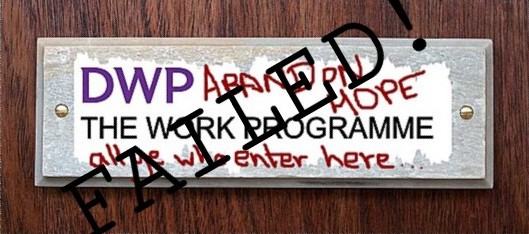
The government’s flagship Work Programme has failed to reach its own minimum standard of results – for the second year running.
The Department for Work and Pensions said 13 per cent of jobseekers had managed to find work lasting at least six months (three months for the hardest to help) – but targets for the second year were higher than the first and the DWP admitted that the Work Programme has failed to meet them.
Of the 1.02 million who have been on the programme long enough to count in today’s figures, 132,000 people found work lasting long enough to be counted a success according to its (low) standards. Six months in work is not a long-term job.
This totals 13.4 per cent. Broken down into particular payment groups, Work Programme providers got 31.9 per cent of JSA claimants aged 18-24 into sustained work against a contracted level of 33 per cent – so that is a fail. For JSA claimants aged 25 or over, they averaged 27.3 per cent against a contracted level of 27.5 per cent – so that is also a fail.
We should concede that this is a big improvement from the first year, when no provider reached their contracted level of 5.5 per cent for either group.
But 31.9 per cent and 27.3 per cent creates a combined average of 29.6 per cent, so you’re probably wondering why the Work Programme’s actual average is 13.4 per cent.
Part of this has to do with the total for people on Employment and Support Allowance. The achievement for ESA new customers was just 5.3 per cent, against a target of 16.5 per cent – and is therefore a bitter fail.
This still does not create a combined figure of 13.4 per cent but I am momentarily at a loss to find any other figures to account for it in the statistical release or the DWP’s press release.
This – the press release – is a piece of comedy rather than information, as we have come to expect from the Department of Wayward Pronoouncements.
It makes no mention of the abject failure to meet ESA targets but states: “Compared to many employment schemes under previous governments, the programme targets the hardest to help into work, such as those claiming Employment and Support Allowance.”
That’s a shot in the foot right there, because it immediately sent me looking for the relevant – and damning – figures.
The omission here, coupled with the recent BBC news report in which WP providers got their begging bowls out and demanded more cash to help ESA claimants into work, creates a bleak picture for sick and disabled people who are being forced to seek employment and reinforces the position set out in a previous Vox Political article that these are people who are too ill to work and should not be forced to seek it.
It’s a lose-lose scenario: The Work Programme providers will fail to hit their targets and the ESA recipients’ health will suffer.
And we all know that the DWP is hiding the figures showing how many ESA recipients are dying every week as a result of participation in its brutal assessment process and silly work placement schemes.
Employment minister Mark Hoban, commenting on the programme’s failure to meet its contracted targets, said: “The Work Programme is helping large numbers of people escape the misery of long-term unemployment and get back into real jobs. The improvement in performance over the past year has been profound and the scheme is getting better and better.”
So we know that he’s living in a fantasy world.
In fairness, it should be pointed out that 18 out of the 40 Work Programme providers have met or exceeded their targets. Unfortunately we don’t know how they managed this; considering some of the horror stories that have come from the schemes, it seems a miracle that anyone got a job at all.
Oh, and there’s a sideswipe at commenters like Vox Political. The statistical summary states: “Many commentators on the previous statistical release looked to compare total job outcome payments with total referrals in the period covered by that publication (June 2011 to July 2012) and assess this against a minimum benchmark.
“Incorrectly the media calculated 3.5 per cent (using data covered by full release period) and 2.3 per cent (using data from June 2011 to May 2012) as the relevant figure to compare against the 5.5 per cent benchmark. The contractual benchmark is measured each financial year for three specific groups of Participants only.”
The press release states that – for once – the DWP has an endorsement from the UK Statistics Authority: “The UK Statistics Authority has said that it does not regard the calculation by commentators that 3.5% of people got into work in the first year of the scheme is the most relevant figure on which to assess performance.
“It agrees with the DWP that performance is better measured by counting how many people referred to the Work Programme get into sustained employment within a year of being referred to the scheme.”
That’s very nice. It would have been even nicer to have been provided with the correct figure at the time. I remember wondering why vital information had been omitted from the releases provided to us, forcing us to make the best calculations we could with what was available.
If the DWP wants to play silly games with the figures, its people have no right to come crying to the rest of us, just because we have tried to fill the gap.
To summarise: The Work Programme has failed to hit targets in its second year, with the results being particularly disastrous for the sick and disabled.